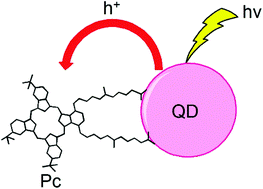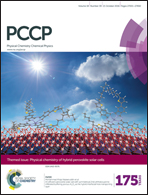Photoinduced hole transfer in QD–phthalocyanine hybrids†
Abstract
A series of CdSe quantum dot (QD)–phthalocyanine (Pc) hybrids were synthesized and their photophysics was studied using steady state and time-resolved spectroscopic methods. Emission of QDs was progressively quenched upon increasing the concentration of Pc in the hybrids. A detailed transient absorption study of the hybrids revealed that the mechanism of quenching is charge separation, resulting in the formation of hybrids with negatively charged QDs and the Pc cation. Direct photo-excitation of Pc did not show any detectable interaction between the excited state of Pc and the QD to which it is attached. An explanation is proposed, based on the suggestion that the energy of the lowest unoccupied molecular orbital (LUMO) of Pc is lower than the lower edge of the QD conduction band, while the energy of the highest occupied molecular orbital (HOMO) of Pc is sufficiently higher than the high energy edge of the QD valence band (VB), thus permitting hole transfer from the QD VB to the Pc HOMO after photo-excitation of QDs.



 Please wait while we load your content...
Please wait while we load your content...